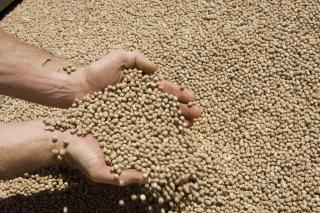The pig’s requirements
The pig’s nutritional requirements for optimal and healthy growth change and are influenced by factors such as:
Age and body weight
A weaner/young pig requires a diet higher in protein and energy than does a finisher pig or an adult pig.
Genetic potential of your pigs
Fast growing breeds (e.g. Large White, Landrace, Duroc) require more protein in their diet than breeds that do not grow as fast (e.g. Berkshire, Hampshire).
Housing environment
For example, if pigs are in a cold or hot environment (outdoors during winter or summer) they will use more energy just to stay warm or cool, therefore to maintain growth higher levels of energy in the diet will be required.
Physiological state of the pig
A pregnant sow will have different energy and nutritional requirements to a sow that is feeding piglets, or a young pig that is growing rapidly.
There are a range of manufactured complete feeds available from stockfeeders formulated to meet the requirements of different types of pigs. Feed companies, stockfeed manufacturers or private consultants can also assist with formulating manufactured diets according to your (and your pig’s) particular needs. In commercial pig production the cost of feed contributes to 60-75% of the total operating cost. Therefore failing to match the composition of diets with actual requirements of the pig not only affects the pig’s, health and wellbeing but also its growth and performance (in terms of reproduction and meat production) and also the cost of keeping the pigs.
Feed ingredients
Pigs are monogastric (single stomach) animals and are inefficient digesters of fibre (only 50% efficiency depending on type of fibre and age of pigs) therefore they are not suited to eating pasture alone and need to be provided with supplementary feeding. It is recommended that pigs are provided with a complete (manufactured) diet or a home mixed diet that has been formulated to meet the pig’s needs. Cereal grains are a good feed source although they are best utilised by the pig if they have been cracked, rolled or soaked.
The major ingredients used by the Western Australian pig industry are wheat, barley and lupins, but other grains such as peas, canola meal and triticale are also used. The crude protein content of grains can vary considerably between seasons and source therefore it is important that care be taken if using apparently low cost ingredients of an inferior quality (e.g. weather damaged cereals).
Pigs are omnivores therefore will eat a range of foods. If mixing your own feed, to produce a well-balanced diet, a range of other ingredients should be included in smaller amounts (e.g. meat meal, fishmeal, soybean meal, blood meal, tallow, minerals, vitamins, salt, limestone).
Pig diets can also be supplemented with fresh fruit and vegetables however you must be certain that the feedstuff cannot be classified as swill. Swill feeding is illegal. Find out more about swill.
More information about feeding pigs can be found at:
Water
Fresh water should be available at all times and accessible to all pigs (including piglets). The water supply should be cool (maximum 18-20°C). Supply lines should be buried or insulated particularly if they are black poly pipe outside in the full sun; otherwise the water is hot and undrinkable when it is most needed.
If nipple drinkers are used it should be checked that the water pressure coming through the drinkers is suitable for the age group of pigs to allow sufficient water intake. As a guide: 0.5 litres/min for piglets and weaners, 1.0 litres/min for growing pigs and dry sows and 2.0 litres/min for lactating sows.
| Age of pig | Flow rate | Maximum pressure (kPa) |
| Lactating sow | 2L/minute | No limit (avoid wastage) |
| Dry sows and boar | 1L/minute | No limit (avoid wastage) |
| Finisher | 1L/minute | 140-175 |
| Grower | 1L/minute | 140-175 |
| Weaner | 0.5L/minute | 85-105 |
See more on water related recommendations.


